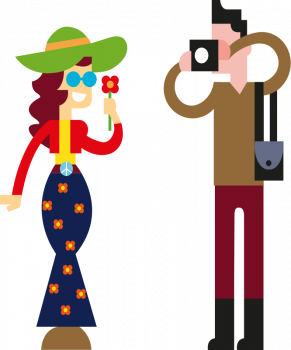Describing Looks Posted by Bjørn A. Bojesen on Jan 31, 2019 in Conversation
Hvordan ser han/hun ut? How does he/she look? You might not carry around photos of everyone you know in mobilen din (your mobile phone), so now and then you’ll need ord (words) to describe somebody’s utseende (appearance, literally ”out-looking”).
Høy, lav, stor, kraftig, liten, tykk, tynn (tall, short, big, strongly built, small, thick/stout, thin) – these basic words for body shapes work approximately as in English: Bestefaren min er en liten, tykk mann. (My grandfather is a little stout man.) Hun er høy og slank. (She’s tall and slim – well, there you got another neat adjective! 🙂 )
NB! liten sometimes takes the feminine form lita, as in jenta vår er lita og sjenert (our girl is small and shy).
Although many outsiders think of Norwegians as the blue-eyed and blonde heroes of the TV series Vikings, people in modern Norway of course have all kinds of eye and hair colours (and skin tones):
Hun har blå/grønne/brune øyne. (She’s got blue/green/brown eyes.)
Håret hans er langt og krøllete. (His hair is long and curly.)
Hun har kort, glatt hår. (She’s got short, straight hair.)
Begge har blondt/brunt/rødt/svart/lyst/mørkt/hvitt/grått hår. (Both have got blonde/brown/red/black/light/dark/white/grey hair.)
Han er skallet med skjegg og bart. (He’s bald with beard and moustache.)
Of course there are many more ways to describe people’s look, including alder (age), klær (clothing) and accessories (such as rings or tattoos). Here are just a few suggestions:
Ei gammel dame med fletter og mange smykker (an old lady with braids and lots of jewellery)
En ung mann med hatt og fregner (a young guy with hat and freckles)
En sporty familie med fargerike luer og skjerf (a sporty family with colourful caps and scarves)

Build vocabulary, practice pronunciation, and more with Transparent Language Online. Available anytime, anywhere, on any device.





Comments:
Angela Barrand:
Do Danes Swedes and Norwegians understand each other when chatting?
Bjørn A. Bojesen:
@Angela Barrand @Angela – that’s a very good question; thanks! I’d say that Norwegians understand 90% of what Swedes are saying and 60% of what Danes are saying. Swedes understand 70% of what Norwegians are saying and 20-25% of what Danes are saying. Danes understand 60% of what Norwegians are saying and 40% of what Swedes are saying. Just my estimates, based on my own experiences! 🙂 It’s a good idea for a post; we’ll see.
Steve Leovy:
Again, thanks for the helpful post.
In the spirit of reciprocity I note that while you refer above to “how does he/she look like,” this is not quite correct English. You can talk about how something looks, or what something looks like, but not (in proper English) to how something looks like. I have noted this in native speakers of Serbian and Korean in recent weeks as well, and I think this is something of a subtle point.
Bjørn A. Bojesen:
@Steve Leovy @Steve Thank you for pointing this out. Yes, this is a subtlety I’ve never thought of. Languages are fascinating, aren’t they? 🙂 I’ll edit accordingly…